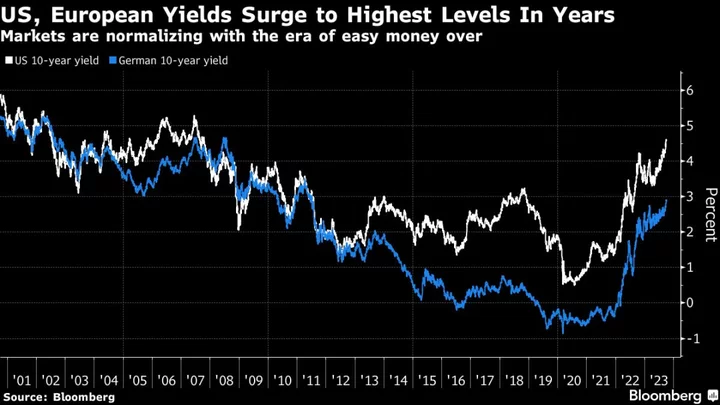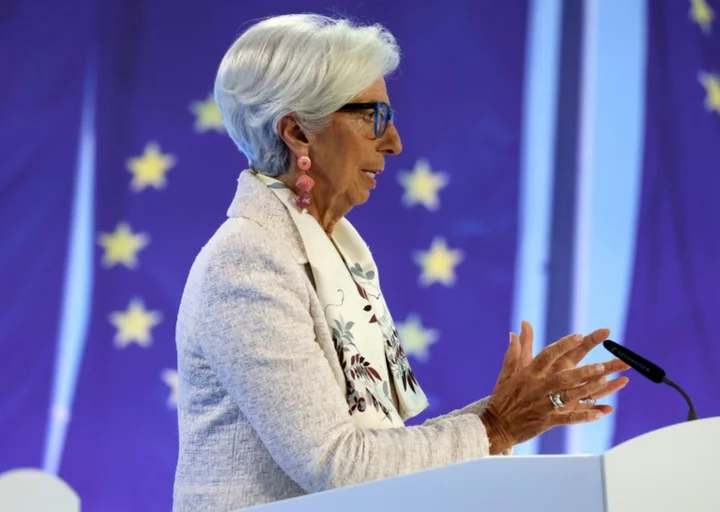It was the week that bond markets finally seemed to grasp what central bankers have been warning all year: higher interest rates are here to stay.
From the US to Germany to Japan, yields that were almost unthinkable at the beginning of 2023 are now within reach. The selloff has been so extreme it’s forced bullish investors to capitulate and Wall Street banks to tear up their forecasts.
Yields on 10-year German debt are close to 3%, a level not reached since 2011. Their US equivalent are back in line with the average from before the Global Financial Crisis and within striking distance of 5%.
The question now is how much higher they can go, with no real top in sight after key levels were broken. While some argue the moves have already gone too far, others are calling it the new normal, a return to the world that prevailed before the era of central bank easy money distorted markets with trillions of dollars of bond buying.
The implications stretch far beyond markets to the rates paid on mortgages, student loans and credit cards, and to the growth of the global economy itself.
At the heart of the selloff were the world’s longest-dated government securities, those most exposed to the ever growing list of headwinds. Oil prices are rising, the US government is piling on more debt and at risk of another shutdown, and tensions with China are on the rise. For anyone who doubted the tough inflation-fighting talk of Jerome Powell and Christine Lagarde against this backdrop, the read-across is not pretty.
“What happened over the last few months was basically markets were wrong because they thought inflation would come down quickly and central banks would be very dovish,” said Frederic Dodard, head of asset allocation at State Street Global Advisors. “Everything will depend about how inflation lands over the medium to long run, but it’s fair to say that we have changed from the ultra low-yield regime.”
Some of the world’s most prominent investors, including BlackRock Inc.’s Larry Fink and Pershing Square Capital’s Bill Ackman, are among those saying the current trend may not be done.
Already, the milestones have been coming thick and fast. Germany’s 10-year yield just had its biggest monthly jump this year. Japan’s government bonds saw their worst quarterly selloff in a quarter century and the US 30-year yield posted its largest quarterly jump since 2009.
Even a US government shutdown hasn’t spurred a sustained bid for Treasuries, the world’s defacto haven asset. House Republicans on Friday failed to pass a short-term funding bill, making a lengthy federal closure more likely.
Amid the rout, few corners of the market escaped damage. Austria’s century bond, a poster-child for long-dated debt issued during the low-rate era, took a fresh drubbing, falling to 35 cents on the euro.
Meanwhile, central bankers continued to try to give the market a clear message.
Fed officials mainly stuck to their mantra of higher-for-longer rates. In Europe, ECB President Lagarde is pushing back strongly against the idea of imminent relief. She told the European Parliament at the start of the week that the central bank would keep interest rates at sufficiently restrictive levels for as long as necessary to cool inflation.
Some chastened bond bulls such as T.Rowe Price got ahead of September’s rout, flipping long bets on Treasuries to shorts. Big block trades this week in Treasury futures targeted a steeper curve and higher long-dated yields.
Until now, the aggressive rate hikes unleashed by central banks had taken the greatest toll on shorter maturities, driving yields up and resulting in deeply inverted curves. Expectations of recessions, along with rate cuts in response, had kept longer-end yields pinned down.
But in the US at least, that recession never showed up, forcing investors to price out monetary loosening. European economies have proved less resilient, but the ECB — which has a single mandate of price stability — has reiterated time and again that it’s too soon to talk about easing with inflation still well above its 2% target.
Exacerbating the bond moves is a rise in the compensation investors demand for holding longer-dated debt. In Europe, that so-called “term premium” could add 50 basis points to 10-year rates, according to Societe Generale.
“Rebuilding term premium can only feed long-end steepening forces,” said Adam Kurpiel, a rates strategists at the French bank. “It looks like the pain trade of even higher yields could continue until something breaks.”
To be sure, there’s a view from some that the selloff has already gone too far. Take Jack McIntyre, a portfolio manager at Brandywine Global Investment Management, who has been overweight Treasuries for much of the year and now senses a long-looked-for turning point.
“I think we are in the fear stage for Treasuries, and that won’t last,” he said. “In our mind, inflation is settling and growth will slow. We will get there in six months.”
Notable too was a revised forecast from Goldman Sachs strategists, who now see 10-year Treasuries ending the year at 4.30%. While that’s some 40 basis points higher than their previous target, it’s below current levels.
At Candriam, global head of multi-asset Nadège Dufossé says the current market trend may not have much more to run, and she’s is considering gradually shifting into longer maturities.
“We believe we are at the end of this movement, with signs of decelerating inflation and economies weakening in Europe,” she said. “We need to endure this overshoot phase in long rates and take advantage of it.”
Even if the pressure on the long end starts to ease, another major test lies ahead as the Bank of Japan — the laggard among central banks globally — edges toward normalizing policy. Yields have already crept to multi-year highs ongoing despite efforts by policymakers to stymie the moves.
“Japan we do think is a live issue and there’s a debate to be had about what impact that should have on the global market,” said Martin Harvey, a portfolio manager at the Hartford World Bond Fund. “It’s a potential catalyst for further steepening and one that we need to monitor.”
As the week drew to a close, one piece of data offered the Fed some hope that it’s getting on top of the inflation battle. Its preferred measure of underlying price growth rose at the slowest monthly pace since late 2020.
But even if the inflation picture continues to soften in the US and elsewhere, it’s clear markets are in a new world.
“We’re just maybe reverting back to what the world looked like before 2008,” said Rob Robis, chief global fixed income strategist at BCA Research. “That period post-Lehman, pre-Covid, was one of inflation struggling to stay at 2%, growth being kind of choppy and central banks having to keep rates very low for longer.”
--With assistance from Anchalee Worrachate, Ye Xie, James Hirai, Sujata Rao and Dayana Mustak.









